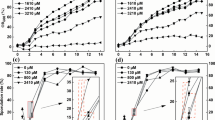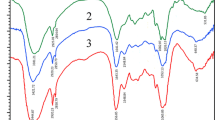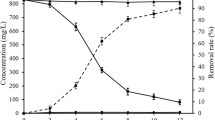Abstract
To increase the bioaccumulation of Eu(III), low temperature plasma as a method of mutagenesis was introduced to mutate Cladosporium sphaerospermum (C. sphaerospermum). Mycelia doses, pH, and ionic strength obviously affected the Eu(III) immobilization on mycelia. The maximum immobilization capacities of Eu(III) on mutated C. sphaerospermum was 278.8 mg/g at pH 6.5, which was approximately three times than that of raw C. sphaerospermum. Before and after Eu(III) loaded mycelia were analyzed by XPS and FTIR, and intracellular structures of mycelia changed obviously under Eu(III) stress by TEM analysis. The results suggested that low temperature plasma could be utilized as a valuable treatment technology to improve fungi for the removal and immobilization of radionuclides in the environment.






Similar content being viewed by others
References
Sheng GD, Yang ST, Li YM, Gao X, Huang YY, Hu J, Wang XK (2014) Retention mechanisms and microstructure of Eu(III) on manganese dioxide studied by batch and high resolution exafs technique. Radiochim Acta 102:155–167
Fan QH, Tan XL, Li JX, Wang XK, Wu WS, Montavon G (2009) Sorption of Eu(III) on attapulgite studied by batch, XPS, and EXAFS techniques. Environ Sci Technol 43:5776–5782
Wang XX, Yang SB, Shi WQ, Li JX, Hayat T, Wang XK (2015) Different interaction mechanisms of Eu(III) and 243Am (III) with carbon nanotubes studied by batch, spectroscopy technique and theoretical calculation. Environ Sci Technol 49:11721–11728
Wang XX, Yu SJ, Chen ZS, Song WC, Chen YT, Hayat T, Alsaedi A, Guo W, Hu J, Wang XK (2015) Complexation of radionuclide 152+154Eu (III) with alumina-bound fulvic acid studied by batch and time-resolved laser fluorescence spectroscopy. Sci China Chem 60:107–114
Sun YB, Wu ZY, Wang XX, Ding CC, Cheng WC, Yu SH, Wang XK (2016) Macroscopic and microscopic investigation of U(VI) and Eu(III) adsorption on carbonaceous nanofibers. Environ Sci Technol 50:4459–4467
Chen CL, Wang XK, Nagatsu M (2009) Europium adsorption on multiwall carbon nanotube/iron oxide magnetic composite in the presence of polyacrylic acid. Environ Sci Technol 43:2362–2367
Xie Y, Helvenston EM, Shuller-Nickles LC, Powell BA (2016) Surface complexation modeling of Eu(III) and U (VI) interactions with graphene oxide. Environ Sci Technol 50:1821–1827
Sun YB, Lu SH, Wang XX, Xu C, Li JX, Chen CL, Chen J, Hayat T, Alsaedi A, Alharbi NS, Wang XK (2017) Plasma-facilitated synthesis of amidoxime/carbon nanofiber hybrids for effective enrichment of 238 U(VI) and 241 Am(III). Environ Sci Technol 51:12274–12282
Yu SJ, Wang XX, Yang ST, Sheng GD, Alsaedi A, Hayat T, Wang XK (2017) Interaction of radionuclides with natural and manmade materials using XAFS technique. Sci China Chem 60:170–187
Bouby M, Lutzenkirchen J, Dardenne K, Preocanin T, Denecke MA, Klenze R, Geckeis H (2010) Sorption of Eu(III) onto titanium dioxide: measurements and modeling. J Colloid Interface Sci 350:551–561
Konstantinou M, Pashalidis I (2008) Competitive sorption of Cu(II), Eu(III) and U(VI) ions on TiO2 in aqueous solutions—a potentiometric study. Coll Surf A 324:217–221
Wang XX, Yu SJ, Chen ZS, Zhao YS, Jin J, Wang XK (2017) Microstructures and speciation of radionuclides in natural environment studied by advanced spectroscopy and theoretical calculation. Sci China Chem 60:1149–1152
Galunin E, Alba MD, Santos MJ, Abrão T, Vidal M (2010) Lanthanide sorption on smectitic clays in presence of cement leachates. Geochim Cosmochim Acta 74:862–875
Schnurr A, Marsac R, Rabung T, Lützenkirchen J, Geckeis H (2015) Sorption of Cm(III) and Eu(III) onto clay minerals under saline conditions: batch adsorption, laser-fluorescence spectroscopy and modeling. Geochim Cosmochim Acta 151:192–202
Dolatyari L, Yaftian MR, Rostamnia S (2016) Adsorption characteristics of Eu(III) and Th(IV) ions onto modified mesoporous silica SBA-15 materials. J Taiwan Inst Chem Eng 60:174–184
Song WC, Liang J, Wen T, Wang XX, Hu J, Hayat T, Alsaedi A, Wang XK (2016) Accumulation of Co(II) and Eu(III) by the mycelia of Aspergillus niger isolated from radionuclide-contaminated soils. Chem Eng J 304:186–193
Singh M, Srivastava PK, Verma PC, Kharwar RN, Singh N, Tripathi RD (2015) Soil fungi for mycoremediation of arsenic pollution in agriculture soils. J Appl Microbiol 119:1278–1290
Purchase D, Scholes LNL, Shutes Revitt DM (2009) Effects of temperature on metal tolerance and the accumulation of Zn and Pb by metal-tolerant fungi isolated from urban runoff treatment wetlands. J Appl Microbiol 106:1163–1174
Sun J, Zou X, Ning Z, Sun M, Peng J, Xiao T (2012) Culturable microbial groups and thallium-tolerant fungi in soils with high thallium contamination. Sci Total Environ 441:258–264
Wu Y, Wen Y, Zhou J, Dai Q, Wu Y (2012) The characteristics of waste Saccharomyces cerevisiae biosorption of arsenic(III). Environ Sci Pollut Res 19:3371–3379
Laroussi M, Richardson JP, Dobbs FC (2002) Effects of nonequilibrium atmospheric pressure plasmas on the heterotrophic pathways of bacteria and on their cell morphology. Appl Phys Lett 81:772–774
Zhang X, Zhang XF, Li HP, Wang LY, Zhang C, Xing XH, Bao CY (2014) Atmospheric and room temperature plasma (ARTP) as a new powerful mutagenesis tool. Appl Microbiol Biotechnol 98:5387–5396
Chen HX, Xiu ZL, Bai FW (2014) Improved ethanol production from xylose by Candida shehatae induced by dielectric barrier discharge air plasma. Plasma Sci Technol 16:602–607
Dong XY, Xiu ZL, Li S, Hou YM, Zhang DJ, Ren CS (2010) Dielectric barrier discharge plasma as a novel approach for improving 1,3-propanediol production in Klebsiella pneumoniae. Biotechnol Lett 32:1245–1250
Wang LY, Huang ZL, Li G, Zhao HX, Xing XH, Sun WT (2010) Novel mutation breeding method for Streptomyces avermitilis, using an atmospheric pressure glow discharge plasma. J Appl Microbiol 108:851–858
Qi F, Kitahara Y, Wang Z, Zhao X, Du W, Liu D (2014) Novel mutant strains of Rhodosporidium toruloides by plasma mutagenesis approach and their tolerance for inhibitors in lignocellulosic hydrolyzate. J Chem Technol Biotechnol 89:735–742
El-Sayed MT (2015) An investigation on tolerance and biosorption potential of Aspergillus awamori ZU JQ 965830.1 to Cd(II). Ann Microbiol 65:69–83
Song WC, Wang XX, Tao W, Wang H, Hayat T, Wang XK (2016) Enhanced accumulation of U(VI) by Aspergillus oryzae mutant generated by dielectric barrier discharge air plasma. J Radioanal Nucl Chem 310:1353–1360
Ma J, Zhang H, Cheng C, Shen J, Bao L, Han W (2016) Contribution of hydrogen peroxide to non-thermal atmospheric pressure plasma induced a549 lung cancer cell damage. Plasma Proces Polym 9999:1–12
Song WC, Wang EJ, Gao Y, Wu JB, Rao SH, Wang HZ, Bao LZ (2017) Low temperature plasma induced apoptosis in CNE-2Z cells through endoplasmic reticulum stress and mitochondrial dysfunction pathways. Plasma Proces Polym. https://doi.org/10.1002/ppap.201600249
Prasad KS, Ramanathan AL, Paul J, Subramanian V, Prasad R (2013) Biosorption of arsenite (As + 3) and arsenate (As + 5) from aqueous solution by Arthrobacter sp. biomass. Environ Technol 34:2701–2708
Yuzer H, Kara M, Sabah E, Celik MS (2008) Some experiments on the precipitation of suspensoid protein by various ions and some suggestions as to its cause. J Hazard Mater 151:33–37
Strawn DG, Sparks DL (1999) The use of XAFS to distinguish between inner- and outer-sphere lead adsorption complexes on montmorillonite. J Colloid Interf Sci 216:257–269
Ding CC, Feng S, Cheng W, Zhang J, Li X, Liao J, Liu N (2014) Biosorption behavior and mechanism of thorium on Streptomyces sporoverrucosus dwc-3. J Radioanal Nucl Chem 301:237–245
Texier AC, Andres Y, Cloirec PL (1997) Selective biosorption of lanthanide (La, Eu) ions by Mycobacterium smegmatis. Environ Technol 18:835–841
Texier AC, Andres Y, Cloirec PL (1999) Selective biosorption of lanthanide (La, Eu, Yb) ions by Pseudomonas aeruginosa. Environ Sci Technol 33:489–495
Oliveira RC, Hammer P, Guibal E, Taulemesse JM, Garcia O (2014) Characterization of metal–biomass interactions in the lanthanum(III) biosorption on Sargassum sp. using SEM/EDX, FTIR, and XPS: preliminary studies. Chem Eng J 239:381–391
Song WC, Wang XX, Wang Q, Shao DD, Wang XK (2015) Plasma-induced grafting of polyacrylamide on graphene oxide nanosheets for simultaneous removal of radionuclides. Phys Chem Chem Phys 17:398–406
Yuan SJ, Sun M, Sheng GP, Li Y, Li WW, Yao RS, Yu HQ (2010) Identification of key constituents and structure of the extracellular polymeric substances excreted by Bacillus megaterium TF10 for their flocculation capacity. Environ Sci Technol 45:1152–1157
Tan XL, Fan QH, Wang XK, Grambow B (2009) Eu(III) sorption to TiO2 (anatase and rutile): batch, XPS, and EXAFS studies. Environ Sci Technol 43:3115–3121
Doshi H, Ray A, Kothari IL (2007) Biosorption of cadmium by live and dead Spirulina: IR spectroscopic, kinetics, and SEM studies. Curr Microbiol 54:213–218
Mezaguer M, Kamel N, Lounici H, Kamel Z (2013) Characterization and properties of Pleurotus mutilus fungal biomass as adsorbent of the removal of uranium(VI) from uranium leachate. J Radioanal Nucl Chem 295:393–403
Kumar R, Bhatia D, Singh R, Bishnoi NR (2012) Metal tolerance and sequestration of Ni(II), Zn(II) and Cr(VI) ions from simulated and electroplating wastewater in batch process: Kinetics and equilibrium study. Int Biodeter Biodegr 66:82–90
Li N, Zeng G, Huang D, Huang C, Lai C, Wei Z, Xu P, Zhang C, Cheng M, Yan M (2015) Response of extracellular carboxylic and thiol ligands (oxalate, thiol compounds) to Pb2+ stress in Phanerochaete chrysosporium. Environ Sci Pollut R 22:12655–12663
Srivastava S, Thakur IS (2006) Biosorption potency of Aspergillus niger for removal of chromium(VI). Curr Microbial 53:232–237
McLean J, Beveridge TJ (2001) Chromate reduction by a pseudomonad isolated from a site contaminated with chromated copper arsenate. Appl Environ Microbiol 67:1076–1084
Liu D, Kottke I (2004) Subcellular localization of copper in the root cells of Allium sativum by electron energy loss spectroscopy (EELS). Bioresour Technol 94:153–158
Acknowledgements
This research was supported by National Natural Science Foundation of China (21607156) and China Postdoctoral Science Foundation funded project (2015M581047).
Author information
Authors and Affiliations
Corresponding authors
Rights and permissions
About this article
Cite this article
Liang, J., Li, L. & Song, W. Improved Eu(III) immobilization by Cladosporium sphaerospermum induced by low-temperature plasma. J Radioanal Nucl Chem 316, 963–970 (2018). https://doi.org/10.1007/s10967-018-5751-2
Received:
Published:
Issue Date:
DOI: https://doi.org/10.1007/s10967-018-5751-2




